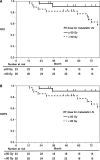Clinical outcomes of definitive whole pelvic radiotherapy for clinical lymph node metastatic prostate cancer
- PMID: 32750234
- PMCID: PMC7520291
- DOI: 10.1002/cam4.2985
Clinical outcomes of definitive whole pelvic radiotherapy for clinical lymph node metastatic prostate cancer
Abstract
Background: In this study, we aim to present the clinical outcomes of radiotherapy (RT) in clinical pelvic lymph node-positive prostate cancer (cN1) patients. We also analyze the prognostic factors with focus on RT dose escalation to metastatic lymph nodes (LN).
Methods: We retrospectively analyzed the data from cN1 patients who were treated with definitive RT and androgen deprivation therapy (ADT) between June 2004 and February 2016. All patients received localized irradiation to the prostate region and whole pelvis irradiation. Some patients received intensity-modulated radiation therapy with RT dose escalation to metastatic LN. Univariate analyses using log-rank test were performed to find prognostic factors between patient subgroups.
Results: Fifty-one consecutive patients were identified. The median follow-up period for all patients was 88 (range 20-157) months. Primary Gleason pattern and LN RT dose were statistically significant prognostic factors for relapse-free survival (RFS) and distant metastasis-free survival (DMFS). Especially, RT dose escalation (60 Gy or more) to metastatic LN significantly improved RFS and DMFS compared with standard dose RT (4-year RFS 90.6% vs 82.1%, 7-year RFS 90.6% vs 58.0%, P = .015; 4-year DMFS 90.6% vs 82.1%, 7-year DMFS 90.6% vs 62.8%, P = .023). The following factors were all statistically significant for biochemical relapse-free survival (BRFS): T stage, LN RT dose, local RT dose, and ADT duration period. Any significantly different toxicity was not seen for each LN or local RT dose except for the incident rate of grade 2 or more acute urinary retention, which was significantly higher in the higher LN RT dose (60 Gy or more) group by the Chi-square test.
Conclusions: RT dose escalation to metastatic LN in cN1 patients improves BRFS, RFS, and DMFS at 4 and 7 years, without increasing severe adverse events.
Keywords: IMRT; dose escalation; lymph node metastases; prostate cancer; radiotherapy.
© 2020 The Authors. Cancer Medicine published by John Wiley & Sons Ltd.
Conflict of interest statement
All authors have no conflict of interest to declare.
Figures

References
-
- NCCN Clinical Practice Guidelines in Oncology Version 2. 2018. Prostate Cancer. Available at: https://www.nccn.org/professionals/physician_gls/pdf/prostate.pdf. Accessed May 25, 2018.
-
- Zagars GK, Pollack A, von Eschenbach AC. Addition of radiation therapy to androgen ablation improves outcome for subclinically node‐positive prostate cancer. Urology. 2001;58:233‐239. - PubMed
-
- Kuefer R, Volkmer BG, Loeffler M, et al. Comparison of external radiation therapy vs radical prostatectomy in lymph node positive prostate cancer patients. Prostate Cancer Prostatic Dis. 2004;7:343‐349. - PubMed
-
- Abdollah F, Karnes RJ, Suardi N, et al. Impact of adjuvant radiotherapy on survival of patients with node‐positive prostate cancer. J Clin Oncol. 2014;32:3939‐3947. - PubMed
-
- Gakis G, Boorjian SA, Briganti A, et al. The role of radical prostatectomy and lymph node dissection in lymph node‐positive prostate cancer: a systematic review of the literature. Eur Urol. 2014;66:191‐199. - PubMed
Publication types
MeSH terms
LinkOut - more resources
Full Text Sources
Medical
Miscellaneous

